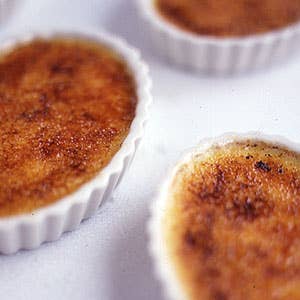
Creme brulee , literally ''burnt cream'', is a silky custard with a brittle caramelized sugar top. It sounds French, but the English often claim to have invented it, linking it to the dining halls of Cambridge University's Trinity College, where it was introduced (and rejected) in the 1860s, then reintroduced (and accepted) in 1879. But wait a minute: A recipe for ''excellent cream'' (basically the custard without the crust) did turn up in a 1677 English book entitled The Complete Servant Maid—but the earliest mention of creme brulee as we know it was apparently in Le cuisinier royal, published in 1691 by French chef François Massialot. (Incidentally, Catalonia also claims to have invented the dish, but there is no evidence to back up its claim.)
Whatever its origins, creme brulee came to the United States sometime in the 19th century, receiving a particularly enthusiastic reception in New Orleans. Not until the 1980s, though, did it win popularity elsewhere in the U.S.—perhaps due to the efforts of Dieter Schorner, then pastry chef at Le Cirque in Manhattan. Sirio Maccioni, the restaurant's celebrated host-owner, supposedly loved Schorner's brulee so much that he wanted all his customers to sample it. The rest is custard history.
Schorner is now chairman of pastry arts at New York's French Culinary Institute, Le Cirque is Le Cirque 2000, and creme brulee is the darling of American dessert menus. Schorner humbly insists that there is nothing special about his recipe, though he does admit to having made a conscious decision to put the custard in individual shallow dishes instead of in a single baking pan (as at Trinity) or tall ramekins (which had been the American custom). Whatever he did, it worked. At one point, Schorner says, Maccioni was eating three servings a day.
Keep Reading
Continue to Next Story










